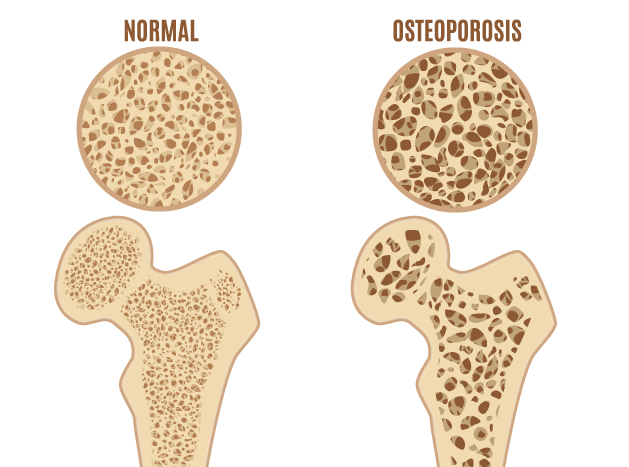World Class Care for Your Bone Health at HOI
- Category: News, Orthopedic Health, Spine, Blog
- Posted On:
- Written By: Michael Gordon, MD
May is Osteoporosis Awareness Month—bringing awareness to a “silent disease” affecting more than 10 million Americans. Impacting primarily women and men over the age of 50, osteoporosis weakens bones without any symptoms until a fracture occurs.
At Hoag Orthopedic Institute (HOI), our experts can offer advice for preventing fractures and provide access to the latest treatment options.
About Osteoporosis
 Osteoporosis is a progressive condition where bones become fragile and more prone to breaking.
Osteoporosis is a progressive condition where bones become fragile and more prone to breaking.
“Healthy bones have a hard outer layer with honeycomblike structure internally,” says Adam Rivadeneyra, MD, a sports medicine physician at HOI with a special interest in osteoporosis. “They are strong, dense and full of tiny spaces that support strength and stability.
In osteoporosis, bone density is decreased and the internal honeycomb structure weakens, making bones fragile and more likely to break from even a minor bump or fall.”
Fractures
Bones that most commonly fracture from osteoporosis are in the vertebrae (bones in the spine), hips and wrist. Vertebral compression fractures occur nearly 1.5 million times every year in the U.S. and are almost twice as common as other fractures linked to osteoporosis. Fractured vertebrae can exaggerate the natural curve of the spine, resulting in a stooped posture or “hump” at the top of the spine.
For osteoporosis patients, a fracture can occur spontaneously or easily from simple activities like reaching, bending or twisting. It can also occur following a minor injury such as a fall from a standing height or less.
“A fracture isn’t just a broken bone, it’s often the first warning sign of underlying bone loss,” says HOI board-certified orthopedic spine surgeon Michael Gordon, MD. “At HOI, we see every fragility fracture as an opportunity to identify and treat osteoporosis before it leads to more serious injury. We continually evaluate protocols to safeguard patients against postoperative fractures and recommend specific treatments, ranging from exercise and appropriate diet to a range of medical interventions.”
Diagnosis
If you have suffered a fracture and have risk factors, your HOI physician will likely order a bone density or dual energy X-ray absorptiometry (DEXA) scan, a noninvasive test that measures bone mineral density using low-dose radiation. All patients who have a fragility fracture and are 50 years or older, women over 65 and men over 70—or younger women or men with risk factors—are highly encouraged to have a bone density test.
Results will come back as a numerical score, known as a T-score. For post-menopausal women and men over 50, T-score results indicate the following:
- Above -1.0: Normal
- Between -1 and -2.5: Low bone density, or osteopenia
- Below -2.5: Osteoporosis
Fracture Management
At HOI, our subspecialized orthopedic specialists treat hundreds of osteoporosis-related fractures every year.
• Advanced Fracture Care: Our physicians use the latest nonsurgical and surgical techniques to ensure the best outcomes for osteoporotic bones.
• Prevention & Education: Our multidisciplinary expert team includes physical therapists and nutrition experts who work with patients to implement fall prevention strategies, weight-bearing exercise plans and nutritional support.
• Own the Bone®: HOI participates in the American Orthopaedic Association’s Own the Bone® quality improvement program, a system aimed at better identifying, evaluating and treating patients that suffer from osteoporosis or low bone density-related fragility fractures. HOI’s dedicated clinical nurse specialist, Marisa R. Swain, MSN, RN, ACNS-BC, PHN, ONC, oversees the program, incorporating measures to reduce future fractures.
HOI is Your Trusted Leader in Bone Health
At HOI, we believe bone health is the foundation of an active, independent lifestyle. This osteoporosis awareness month, prioritize your bone health by getting a DEXA screen if indicated, monitoring your Vitamin D levels, keeping up with healthy lifestyle habits— including a diet high in calcium and vitamin D—and staying active, including doing weight-bearing activities. And if osteoporosis or a fracture affects you or someone you love, HOI is your trusted partner to get you ‘Back to You.’
